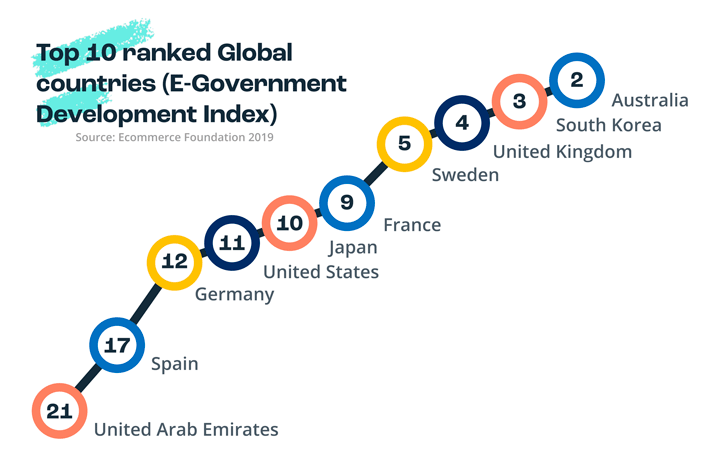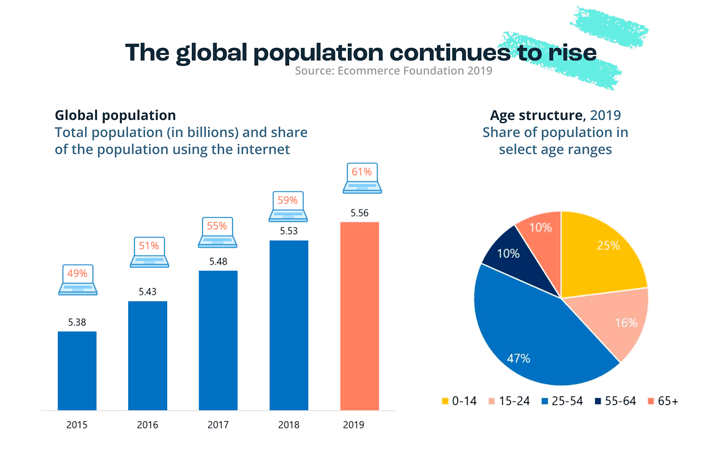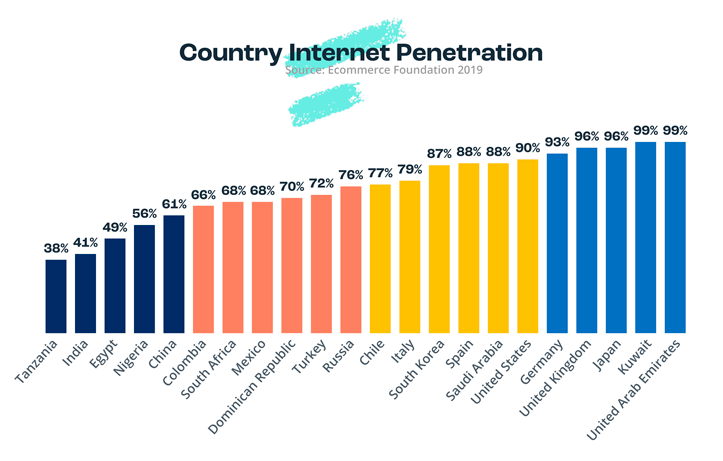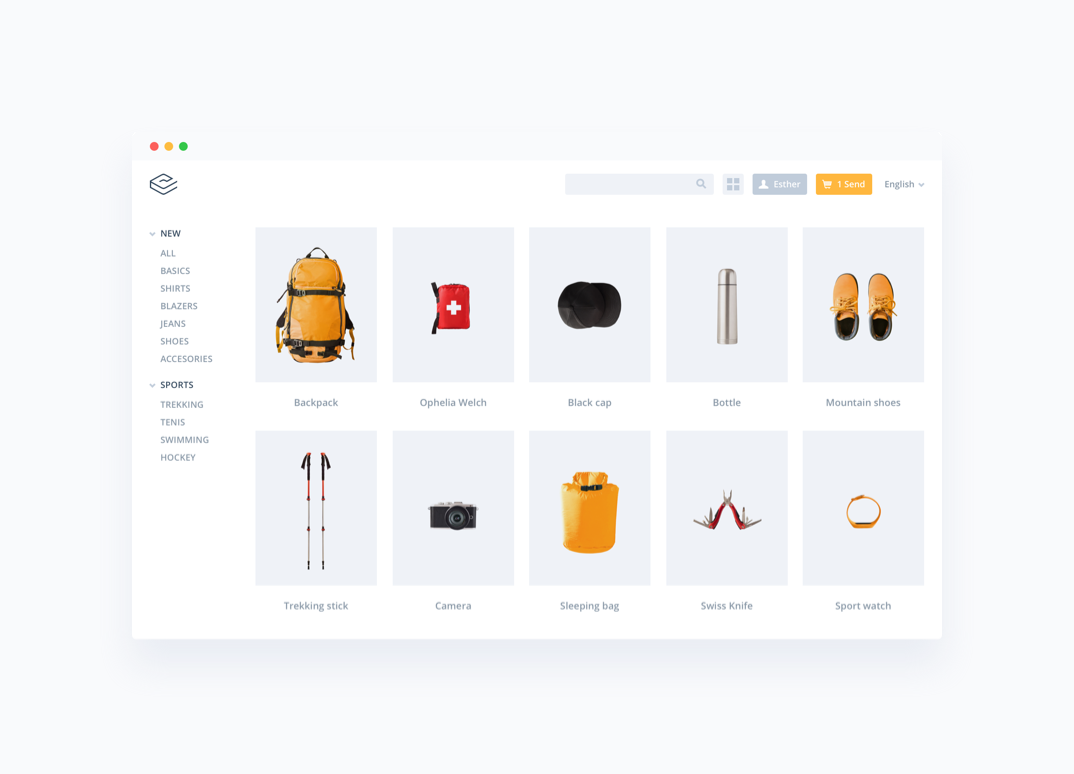
Thanks to the digital transformation, online outlets are proving to be the most lucrative for traditional businesses. In a marketplace where changes in consumption habits coupled with external factors have meant people are turning more to online shopping, companies are rushing to analyze what new markets they can position themselves in.
Choosing which regions and countries to sell your products to will depend on the niche, industry, audience, and logistical resources available to your company (since expanding your market will increase the efforts needed for distribution, catalog management, and control of legal aspects).
Taking a look at global online sales trends can also provide clues to your strategy.
According to the Global Ecommerce Report prepared by the Ecommerce Foundation on the world’s leading B2C ecommerce countries in 2019:
- Europe is the global market with the highest Internet penetration at 85% of the population, with North America following closely behind at 84%.
- Asia and Oceania is the region with the largest population (61% of the global population) and ecommerce sales revenue (44%).
→ Related: How do international buyers behave?

The world’s biggest B2C ecommerce markets for online sales
North America
- Percentage of online buyers among the population: 79.8%
- Average online spending growth rate: 7%
This is one of the biggest ecommerce markets in the world, showing very attractive prospects for online businesses in all its regions, with 82% of the population buying online in the United States, 75% in Mexico, and 73% in Canada.
Although China is the global leading market for total ecommerce sales, the United States still surpasses it in the online retail sales sector.
Europe
- Percentage of online buyers among the population: 72%
- Average online spending growth rate: 2.23%
The countries with the highest ecommerce activity are the United Kingdom (87% of the population buys online), Sweden (84%), and Germany and the Netherlands (83%).
The fewest opportunities are in Romania, where only 27% of the population makes online purchases. Meanwhile, some economic powers such as Italy, which has a modest 48% online buyer rate, do not boast a very large market either.
Spain remains at 63%, although in 2019, it became the European country with the highest growth in ecommerce.
Asia and Oceania
- Percentage of online buyers among the population: 53.4%
- Average online spending growth rate: 2%
These regions include the highest concentration of the global population and markets with very diverse ecommerce characteristics and demands.
Although the level of ecommerce activity is high and similar in South Korea (88%) and Australia (84%), the needs of a business will vary in order to adapt its sales to each of those countries. The types of products with the highest demand, the most intuitive web design for each population, and shipping conditions are all very different, not to mention adapting content management into Korean is a greater challenge than doing so into English.
Japan is another active ecommerce market with 71% of the country buying online. While China is a large exporter and the biggest ecommerce sales market, its population is less inclined to making international purchases and has an ecommerce shopping rate of 59% (in part because of the government’s online access restrictions).
→ If you’re interested in selling online in China: Should you choose AliExpress or Alibaba?

Latin America
- Percentage of online buyers among the population: 46%
- Average online spending growth rate: 2.59%
The largest ecommerce markets in Latin America are Argentina, with 78% of the population engaged in online shopping, and Brazil with 50.6%, though the latter country has the highest volume of ecommerce sales.
Africa
- Percentage of online buyers among the population: 43%
- Average online spending growth rate: 32.5%
The African countries with the highest demand for ecommerce have not yet reached the growth levels of leading economic powers: in Kenya, 65% of the population is active in online shopping, followed by Nigeria and South Africa at 63%.
While these figures may seem unpromising, it is important to remember that Africa is a market with huge inequalities (one that also includes the least developed ecommerce economy in the world: Tanzania). The logistical difficulties of the African market network are not preventing some of its regions from experiencing higher B2C ecommerce growth and stable demand.
Middle East
- Percentage of online buyers among the population: 43%
- Average online spending growth rate: 97%
Like Africa, the Middle East includes a few prominent ecommerce markets as well as regions of very low online penetration.
Among the strongest markets are the United Arab Emirates with 89% of the population engaged in ecommerce activity, Bahrain with 83%, and Qatar with 81%. Meanwhile, in Armenia, only 15% of the population buys online.
Another problem faced by online buyers in the Middle East is that most national retailers still do not offer online shopping facilities. This is encouraging international online shopping, which could be a very interesting window for businesses that want to expand their global network.
Until now, most of these online purchases were made from Chinese sellers, but consumers in the Middle East are increasingly turning to ecommerce businesses based in other countries, with the United States and Germany at the top of the list.
It is important to keep in mind that the Middle East is home to a largely young audience, one more accustomed to using online media and not hesitant to buy international products (especially clothing, electronics, and jewelry).
For example, in Saudi Arabia, 55% of the population is under the age of 30 and nationwide smartphone use is over 65%. Adapting sales strategies to this niche and channel and, of course, offering web and product content in Arabic are keys to success in selling online in the Middle East.
→ Complying with regulations: How to use the Global Data Synchronization Network

Technologies for an international ecommerce sales strategy
Among the trends and technologies that will transform the world’s ecommerce landscape and facilitate business access to global markets, we can find tools that streamline the management and adaptation of multilingual content to different regions and channels at the same time.
Having the right automation and forecasting software can greatly reduce the costs associated with an international business expansion.
AI: Artificial Intelligence
Artificial intelligence will be a key piece in developing ecommerce businesses in all dimensions, but especially when it comes to facilitating rapid international expansion.
Adapting a business to different regions, time zones, and audience profiles requires technology to automate chains of actions and forecast the behavior of markets and customers.
Many AI applications analyze the inventory needs of a business according to patterns of demand and the particular circumstances of each market. They can also evaluate opportunities for advertising and online positioning depending on the traffic your website receives and where it originates from.
In the realm of communication, artificial intelligence is also essential for providing query chatbots at any time and in any language, saving the need to hire a lot of customer support staff and coordinate them across different regions and time zones.
Transportation is another stage of the supply chain that will benefit considerably from artificial intelligence, despite the concerns this technology has raised in the sector. According to a PwC study, autonomous smart cars and trucks could save carriers and the ecommerce companies that hire them up to 30% in energy costs by 2030.
→ Additional trends: Ecommerce technologies that will dominate in 2022
PIM: Product Information Management
A Product Information Management (PIM) solution is a software that facilitates the adoption of omnichannel and international sales strategies more quickly and effectively.
PIM is the most cutting-edge and in-demand technology among today’s manufacturers and sellers, offering a central cloud-based platform with a system for controlling access, edits, and changes. It facilitates management from anywhere in the world and the exporting of product information to any format, channel, or marketplace.

In addition, its functions are continuing to evolve to adapt to ever-changing consumer demands.
The Sales Layer PIM includes the exclusive feature of Instant Catalogs, which allows you to create microsites in a very short time to share the catalog content you want with the users or region of your choice. You can also apply machine translations in hundreds of languages, so that your catalog and newest product releases are ready for any market in less time.
A centralized and cloud-based catalog management approach provides the flexibility you need to adapt to any new market, stay ahead of trends, and stand out from the competition, both domestic and international.
It’s the definitive tool for ensuring reliable content in a marketplace that is increasingly moving toward headless commerce: a network without a single storefront, adapted to multiple platforms and devices.
→ A success story: How Sales Layer helped Bobux strengthen its international network
How to adapt your business to sell online internationally
The overall goal and trend in ecommerce is to design a business experience without friction from physical or digital boundaries. This means a personalized shopping experience for each region and consumer, but one that guarantees the same quality of purchase process, product, information, and shipping in any location.
Your brand and domain should be easy to understand and remember in any language, though this is difficult to keep in mind when starting a company. In addition to having the largest ecommerce activity in the world, China, Germany, and the Netherlands are also the countries with the highest number of registered .shop domains.
You’ll need to adapt your product content to the languages, currencies, and preferences of different regions. As we’ve seen, managing this process centrally in a PIM is the most effective and fastest way to ensure consistent data across the market.
In addition, every marketplace has different requirements and regulations when it comes to uploading and displaying product information and images. Checking out the most popular digital platforms in each region (e.g., Rakuten and Zozo in Japan, Alibaba in China, and Flipkart or Paytm Mall in India) can be a good strategy, though it will depend on the most popular product categories as well as the type of audience being reached.
→ Here are today’s most popular marketplaces in Europe
The challenges of adapting a catalog to different countries
- Promoting your brand in the region
- Building a good reputation and confidence among your target audience
- Adapting to new shipping and delivery methods (as well as expectations of local consumers)
- Customizing content for different languages and preferences related to a product’s featured information, advantages, and benefits
- Displaying prices in the local currency
- Resolving customs and tariff issues (especially in new arenas such as the United Kingdom after Brexit)
- Complying with regional data protection measures (for example, in China, certain data cannot be extracted from local buyers, even on an online platform)
- Securing a network of local distribution and regional warehouses
→ A hot topic: Logistics as a new factor for success in ecommerce
Conclusion
International sales are the next natural step after online sales. The facilities provided by ecommerce to deliver more products to more people and regions bring forth new logistical challenges, but the effort is worth it to expand your brand.
Having management technology that centralizes all the work you do to develop an international catalog is a must for companies with a global and omnichannel strategy.
A PIM solution like Sales Layer allows you to gather, adapt, and distribute all your product information to any corner of the world. This has been demonstrated by our clients based in Europe, Latin America, Australia, and the United States who have succeeded in growing their international network with accurate, up-to-date, and error-free content.
Try it free for 30 days or request a guided demo. Join our group of manufacturers, brands, and retailers with a global vision for the future.










